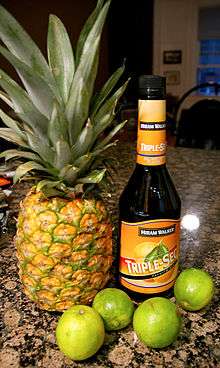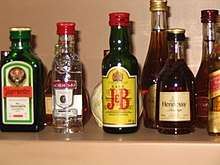Triple sec
 | |
| Type | Liqueur |
|---|---|
| Manufacturer | (various) |
| Country of origin | Saumur, France |
| Introduced | 1849 |
| Alcohol by volume | 15% to 40% [1] |
| Color | Clear, golden, blue |
| Flavor | Orange |
Triple sec, originally Curaçao triple sec, is a strong, sweet and colorless orange-flavored liqueur. It is a variety of Curaçao liqueur, an orange-flavoured liqueur made from the dried peels of bitter and sweet orange.[2]
The etymology of "triple sec" is unclear. The word sec in French means "dry", and the language received it from the Classical Latin word, siccus and the cognate Classical Latin verbal infinitive, siccare, which means "to dry; to dry up; to make dry; to remove moisture."[3] (as in, for example, dessicate). Triple sec may refer to the spirit being distilled three times, having triple the flavor, being three times as dry as other spirits, or it could just be a marketing gimmick.[2][4][5]
Triple sec may be consumed neat as a digestif or on the rocks, but is more typically used as an ingredient in a variety of cocktails such as sangria, margarita, Kamikaze, White Lady, Long Island Iced Tea, Sidecar, Skittle Bomb, Corpse Reviver #2 and Cosmopolitan.
History
The Combier distillery claims that triple sec was invented in 1834 by Jean-Baptiste Combier in Saumur, France.[6] However, Combier was more famous for its élixir Combier, which contained orange but also many other flavorings.[7]
According to Cointreau, its orange liqueur was created in 1849.[5]
Triple sec was certainly widely known by 1878; at the Exposition Universelle of 1878 in Paris, several distillers were offering "Curaço [sic] triple sec" as well as "Curaço doux".[8]
See also
References
- ↑ "Triple Sec". Bar None Drinks. Retrieved 30 July 2018.
- 1 2 English, Camper. "Orange You Glad You Know This?". Fine Cooking. Retrieved 5 July 2018.
- ↑ Harper, Douglas. "sec". Online Etymological Dictionary. Douglas Harper. Retrieved 30 March 2017.
- ↑ Dietsch, Michael. "The Serious Eats Field Guide to Orange Liqueur". Serious Eats. Retrieved 5 July 2018.
- 1 2 "Cointreau". Rémy Cointreau. Retrieved 30 July 2018.
- ↑ "Original Combier". Combier. Retrieved 31 July 2018.
- ↑ "Les liquoristes saumurois" in Saumur jadis, anonymous Web publication at cites Richard Gasnier, Les liquoristes saumurois de 1830 à 1910, mém. de maîtrise, Angers, 2000, B. U. de l'U.C.O., 15 747 ; François Bouyssi et Isabelle Emeriau, "James Combier (1842–1917 ). Essai biographique...", S.L.S.A.S.,, 1992, pp. 46–89 ; Alain Mariez, "Un zeste d'orange, deux doigts d'ambition", L'Anjou, décembre 1995, pp. 70–77 ; Christelle Couvreux, Marie Bardisa, La Distillerie Combier. Saumur, Itinéraires du Patrimoine, 1999.
- ↑ The Lancet Analytical Commission, "Report on the Food Products exhibited in the French and English Departments of the Universal Exhibition of Paris", The Lancet, September 21, 1878, p. 417f.


